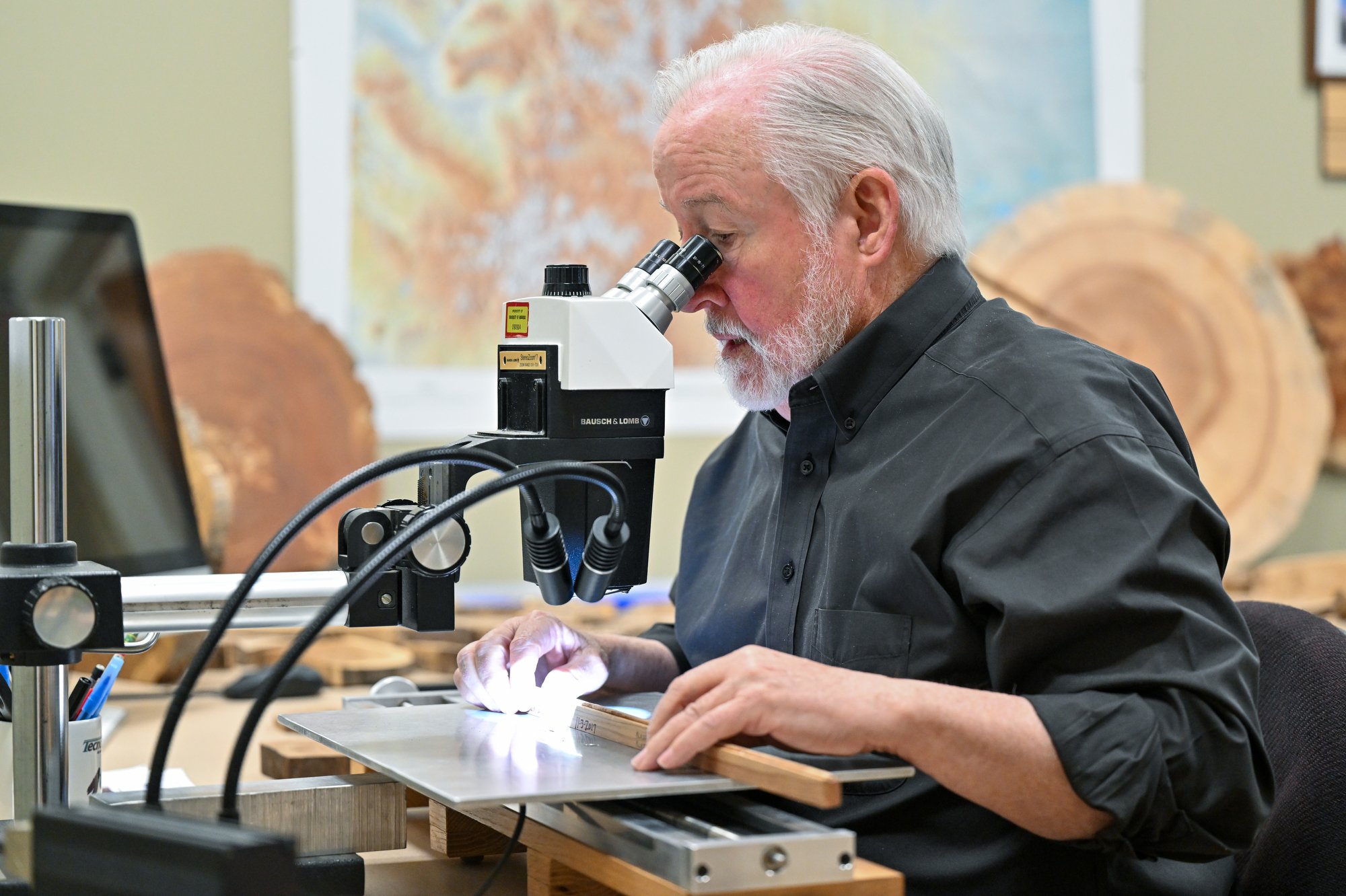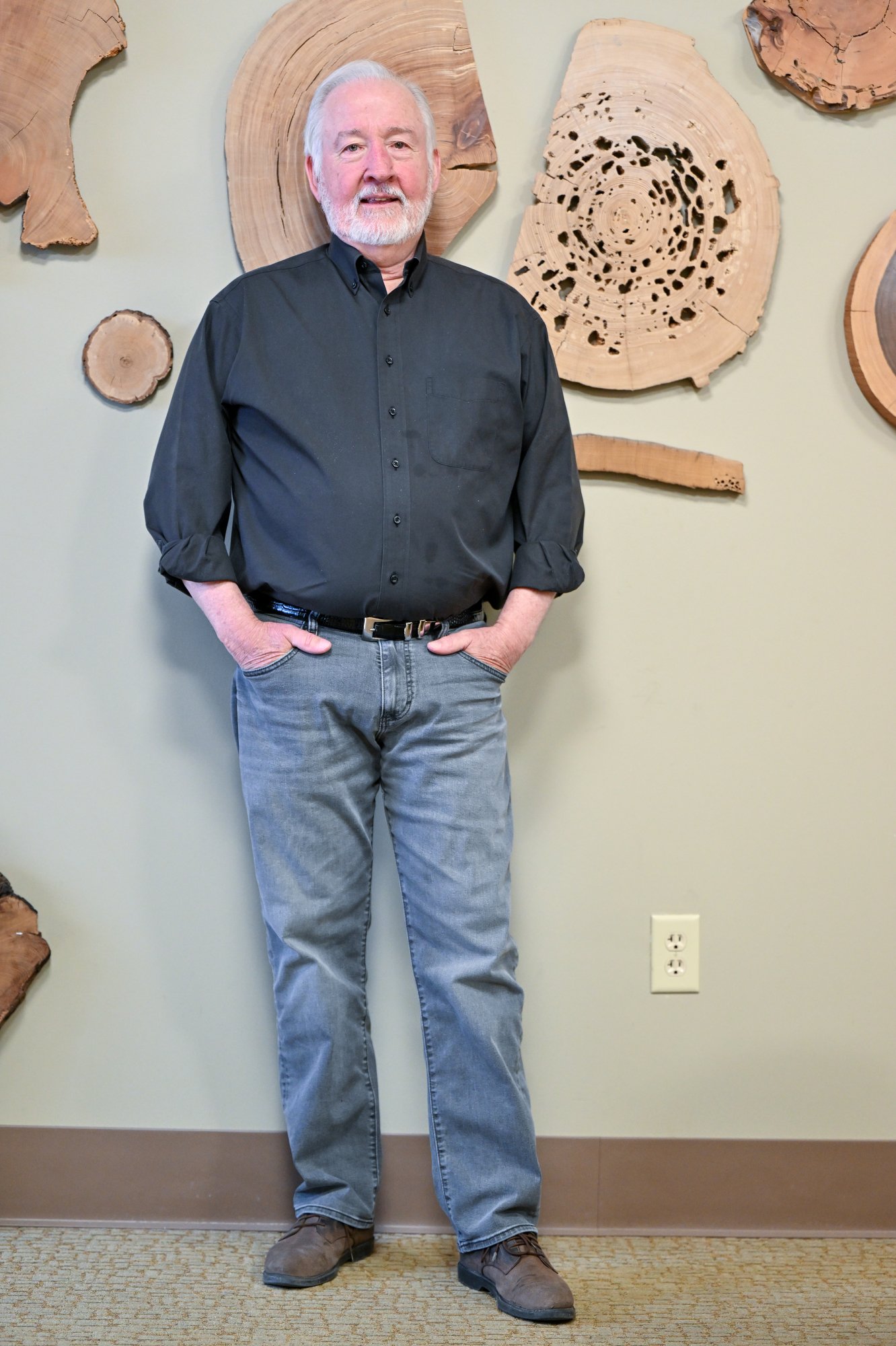PROFILE | David Stahle has dedicated his life to the study of climate change through tree ring research, education and conservation efforts
February 9, 2025
David Stahle is a distinguished professor and director of the tree ring laboratory at the University of Arkansas, but you won’t always find him in the lab at Ozark Hall on the Razorback campus. You’re just as likely to find the world renowned dendrochronologist in the old growth forests of Oklahoma, the swamps of North Carolina or traversing the Great Plains as he searches for trees and takes coring samples from them.
After extraction, in which he’s careful to not damage the living specimen, Stahle brings those samples back to the UA lab, where he uses them to determine wet years and droughts to reconstruct a timeline of climate events. Tree rings are not the only geological indicator of climate (ice cores, ocean sediments and coral reefs are other naturally preserved data that do this too) but there’s a particular benefit to using them for this, he says.
“The thing about tree rings is that it’s exact, flat out exact,” Stahle said. “It’s not plus or minus a year, it’s the year … There’s really very few indicators that are exactly annual, that’s why there’s interest in tree rings.”
For more than four decades this has been his chosen work, reconstructing climate and making chronologies, and Stahle has done it all over the world — in both the southwest and southeast regions of the U.S., in California, Africa, Nepal, and in Mexico partnering alongside a colleague in the Mexican Forest Service.
His research includes locating and studying the oldest known living trees in the Eastern U.S. Recently, this discovery in North Carolina was featured in the September 2023 issue of National Geographic Magazine. Also, many years ago, Stahle documented with tree ring research the Lost Colony drought, which was one of Science Magazine’s top discoveries of the year.
Since 1989, Dr. Stahle has been continuously funded by the National Science Foundation through research grants awarded in three year increments. Short films and reports of his research in Africa, Nepal, Mexico, the U.S., and the Amazon forests of Brazil are available on the UA website. Stahle will retire from the university in May.
Beyond all those high profile accomplishments, Stahle is a conservationist.
“He’s passionate about old growth forests and protecting unique, natural places,” said Mike Stambaugh, professor and director for the Center of Tree-Ring Science at University of Missouri. “Very few people know that the largest tract of old growth forest is in Oklahoma and the credit for knowing that goes to Dave Stahle. Not only did he do the science to discover that, but … he has developed a group centered around recognizing, protecting and studying these unique forests of Oklahoma.”
Given that they are not big trees, and they are not in protected forests or national parks, but mainly across private land, Stambaugh said, most people wouldn’t recognize or particularly care about what makes them special. But Stahle has gone beyond the scientific work and advocated for the protection of these areas.
“I think of Dave as a stone in a pond, the classic example of a ripple effect,” said David Patton, former Coast Guard Commander and Stahle’s friend. “He preaches his enthusiasm for old growth forests and people like me are inspired to ask questions … he’s really changed my life. It’s been quite a ride.”
Through many long conversations, Patton came to understand that “for starters, they’re not making any more of it (old growth forests), so we’ve got to conserve what little bit we got,” he said.
“He did the same thing in California around central valley with Blue Oaks,” Stambaugh said. That’s another effort where Stahle first explained the science of the ecosystem, then advocated for conservation and protection.
Ask him on any given day what he’s most proud of and he’ll tell you his conservation work. Stahle has done a lot of documenting in the Osage Nation and on large private properties “with the goal of trying to educate the landowners about ancient forests that still survive in this region,” Stahle said. “Most who want us to come and study their forest are already interested in it, but when they learn (these) trees are older than the constitution, that only reinforces their interest in conservation and protection of these forests.
“It’s vital for the perpetuation of life on earth. We have to protect habitat for wildlife.”
NOT DONE YET
David Stahle originally came to Arkansas in 1975. After he started doing tree ring research, he got his first National Science Foundation grant in 1979, through the climate dynamics program. Since climate varies over time and many climate variables are 100 years long or less, “in no way does it capture the variability it’s subject to,” Stahle said. “Climatologists have been interested in a longer record.”
They needed more information from researchers like himself to determine what causes that variability of climate and whether it can be predicted. David had a masters degree, but faculty suggested that he get a doctorate.
“It never crossed my mind to be a professor,” Stahle said, but he took their advice and earned his PhD in the ’80s while doing his research. His degree was finalized in 1990, but he had already came on as a faculty member in 1989. “I’ve been in geography and geosciences ever since.”
Stahle earned emeritus status this spring and will continue research, since he has three projects that are still going and already funded.
The first of his ongoing projects is conducting climate reconstruction in the Great Plains, particularly in the corn belt — one of the most active agricultural areas in the world. Stahle is interested in the recurrence of drought and the wetness trend that’s been observed recently over the corn belt.
Whereas ordinarily rain is a good thing that promotes agricultural production, “in this case the wetness trend may be a manifestation of anthropogenic activity, (with) of course the usual suspects of CO2 induced global warming,” he said. Intensive agriculture itself is increasing atmospheric humidity and it’s believed to be leading to greater precipitation. “This is something we want to study in the longer paleo record of trees.”
Michael Stambaugh is working on this project with him and says that the droughts that come on now occur quickly.
“Rather than taking a month or two to set in, some of the droughts now are able to go to extreme conditions in a few weeks,” he said, and they study that with tree rings. The two run around the Great Plains collecting samples from the oldest trees to better understand drought. And while there aren’t many trees in the Great Plains, there are some and they’ve gotten good at locating them. “We look for hiding places trees can survive in the grasslands, in caves or mountains or along rivers.”
Stahle’s second ongoing project is in the Amazon, where it’s not been possible historically to make tree ring chronologies in tropical forests. Most of the trees in the tropics, he says, do not form annual rings since they’re a consequence of the winter/dormant season — except for a mere handful of species.
Stahle is working on that with two Brazilian colleagues Daniela Granato-Souza and Ana Carolina, one is professor at Alabama A&M University and other at Lavras University in Brazil.
“It’s working and it’s amazing,” Stahle said. “We’re able to reconstruct precipitation in the Amazon from these trees, and we’ve compared it with the historical record and identified incredible climate extremes in the 19th century in the Amazon.”
The third project he’s working on is in California on the extreme precipitation events with land falling atmospheric rivers, formerly called the Pineapple Express.
“The storms we’re looking for in Southern California, where it’s been so dry and the fires so catastrophic, they need rain, they need a series of atmospheric rivers to dampen the landscape and reduce the fire risk,” he said.
And finally, Stahle is working on book about the ancient cross timbers. Those timbers are here in the ecotone between the Eastern Deciduous Forest and grasslands of the Southern Plains, Stahle said, and have not been completely destroyed, unlike so many forests that have been logged or converted to some other use in the eastern United States since settlement.
“On the more rugged terrain, it wasn’t worth cutting,” he said. “The trees didn’t get very large, they weren’t a timber resource and … the rough steep rocky ground was not ideal for grazing. Believe it or not a lot of landscape level ancient forest survives in Oklahoma, extreme western Arkansas and north central Texas.”
The book is called “The Ancient Cross Timbers: A natural history of the old growth forest that bordered the Southern Plains” and is under review with the University of Oklahoma Press right now and is likely to be published within the next year.
A TRAVELER STOPS IN ARKANSAS
Young David Stahle didn’t have a hometown exactly. Given that his father was an artillery officer in the military, the whole family traveled the country and world. Over 20 years, his father was stationed in Japan, did three tours in Germany and two tours at Fort Carson, Colo., among other stations.
Stahle went to high school in Colorado Springs, which is where he first met his wife, Donna. They were both 17 when they were in class together, and their first date was walking around downtown after school one day. Soon they were separated for a few years, since after that, Stahle’s parents moved to Fairfax, Va. and he went with them, living there until he began college at UT Austin.
After graduating from the University of Arizona with a bachelor’s in archaeology, Donna and Dave met again, this time in D.C. during a visit and hit it off. They married in 1976.
Since Stahle’s dad was from Pangburn, Ark., he’d made many trips to Arkansas, the whole family stopping in the Natural State to see relatives on their way elsewhere.
“I always liked Arkansas,” Stahle said, looking back on what brought him here to stay. “I was studying archaeology in Tucson and friends told me there was a great archeological program at University of Arkansas.”
At that point, Stahle hoped he would work in the forest service as environmental manager or archaeologist. He came to UA for his masters, intending to study archaeology and environmental law, “but got distracted by tree rings,” he said. “I came here to pursue a career and never left.”
Once planted in Arkansas, Stahle began to study historical buildings. For his masters thesis, he did the same kind of research on log buildings and other historical buildings that he’d done in the southwest. Only this time it included Old Main.
“When they restored Old Main, they had to cut in an elevator shaft” and it went through the primary support beams that hold up the building, Stahle said. Those working on the project threw them away, and David retrieved them from the trash heap. That’s how they got a coring sample and dated them.
While it’s commonly known that Old Main was built between 1872 and 1874, using the timbers that were holding up one of its floors revealed more about the icon of higher education in Arkansas. It allowed Stahle to use it differently: for paleo climate archives to show spring and summer precipitation in Arkansas that they didn’t previously know.
TAKING HOLD
As a boy and young man, David Stahle read National Geographic; he worked in carpentry and read articles about the oldest trees on earth. His interest in his eventual field was piqued while attending the University of New Mexico. There one of his professors lectured about dendrochronology, saying that it helped date the construction of the prehistoric ancestral pueblo of the west and other archaeological sites around the country.
The professor was joking when he claimed UNM was doing that work. But when Stahle dug deeper he found out that it was their rival, University of Arizona, instead. So David transferred to study tree rings and work in the tree ring lab there.
Stahle gained a mentor in Marvin Stokes, who took him along to study the Jesuit and Franciscan-era missionary churches in northwestern Mexico. These were “gorgeous architectural things, monuments really,” and they included wood, making it possible to take core samples to determine when the tree was cut down and the church was built. Some originated from the 16th and 17th centuries.
Doing that work in Tucson and Mexico solidified his career path. Then in Arkansas, Stahle wanted to do similar project for his masters thesis to maintain the archives of historical buildings in Arkansas. He secured small grants to fund it, then got a VW with ladders and generators and traveled the Ozarks and Ouachitas looking for old log buildings and meeting the people of Arkansas who owned them.
“Many of them were pioneer-built log buildings that included wood timbers, heavy logs from the virgin forests of the Ozarks,” Stahle said. He collected 500 timbers during that project, all of which are permanently curated with the UA museum and stored on shelves at the agricultural farm — full of all the timbers he’s collected over a 50 year career. The physical samples will be available for future scientific study.
A TEACHER & HIS STUDENTS
Dan Griffin, a professor at the University of Minnesota, was a newly declared Earth Sciences major in 1999 when he was connected to Dr. Stahle to discuss ideas for his thesis research.
“He was warm and welcoming and obviously a naturally curious person,” Griffin said. “I was quite nervous to meet him, even though at the time I did not fully appreciate the scale of his scientific accomplishments and standing as a top leader in the international community of tree-ring research. He made me feel at ease and made me feel seen.”
Working closely with Stahle continues to be a pivotal experience in Griffin’s life and found that he was endlessly giving with his time and energy. He showed him that science was a viable career pathway and was the first to tell Griffin he might be effective as a university professor.
“He took me all over North America to conduct research in old growth forests,” Griffin said. “He plugged me into his network of scientists. He always treated me like a real collaborator, right from the start.”
Among the pinnacle experiences he’s had with Stahle was traveling to Wilmington, N.C., with Stahle’s graduate students to collect new samples for his bald cypress chronology at the Black River. It required help from Charles Robbins, who guided them into the backwaters of the swampy area known as “The Three Sisters.”
“There, we encountered one of the most remarkable groves of the old-growth forest that either of us had ever seen, rivaling those of California and the Pacific Northwest,” Griffin said. “It was like walking in the land before time.”
Being in that grove of ancient trees was an experience that changed the way he saw the world and grew his respect for trees and forests. A few years later they would return to work the same site and take core samples from the oldest trees in eastern North America at more than 2,600 years old.
“He dotes on his students like puppies,” said Charles Robbins of Cape Fear River Adventures in Wilmington, who helped Stahle get to the areas where he cored trees for eight years. “If they have potential, he’ll bend over backwards to get sponsors, help them go through the process and get jobs. He’s right there and he’s passionate about his work.”
He’s still coring trees, Robbins said, and the business is hard work in areas that are “pretty rough.”
Over the years, Stahle said, he’s had his share of misadventures, like the time he was coring a tree that spanned a ravine and got attacked by a yellow jacket that stung him 45 times on the face and head. Another time he was in a channel when killer bees appeared, causing he and his crew to take off running despite all the gear around their legs and lanyards around their waist.
At one point of Stahle’s work at the Black River, “they realized they had to start climbing trees” to get to the appropriate section for coring, Robbins said. The tops are hollow and the buttress swell, the fat part of the tree at the bottom, rotted out. So they brought ladders to “these 2,000 plus years old (trees) that live in a swamp environment” to reach the middle where it was still solid.
No matter the difficulty or seriousness of the work, Stahle always kept his sense of humor and was an easy person to get along with out in the remote areas, Robbins said. Like the time he surprised everyone by bringing enough hot dogs to grill for lunch and a jar of honey mustard to top them with. Ordinarily they’d have room for only the essentials — backpack with coring tools, lunch, water, compass and books. It tickled them so much that they still call the area they hunkered down for that meal “hot dog ridge.”
Dan Coody, former Mayor of Fayetteville, said David Stahle’s spontaneity and gift of gab always make for a fun evening. He wagers that he has a photographic memory, too.
“He reads everything and can remember facts, names, dates and details on a wide variety of random subjects,” Coody said. “Anytime you are in his company, you will walk away being more knowledgeable about something that you didn’t know would interest you. This is the mark of a truly good teacher.”
The two connected over a shared attraction to beautiful land and since then, Coody has come to appreciate Stahle’s deep love for planet earth. He enjoys walking the woods with him, listening to his stories and says knowing him is to know someone larger than life.
“His perspective is not like that of most of us,” Coody said. “His is the view of someone who feels intimately related to living organisms that are thousands of years old. He understands the life spans of trees that have witnessed millennia of humanity’s failures and successes.”
Date and place of birth: Aug. 10, 1950, El Paso, Texas.
Family: Wife Donna Van Kirk, daughter Laura N. Stahle and son Daniel K. Stahle
How I describe my line of work: Climate variability and climate change imprinted upon the rings of old trees.
Hands down the best (or my personal favorite) tree I’ve ever seen was: That is like asking whom do you love the most, your daughter or your son? But Blue Oak. (Quercus douglasii), Post Oak (Quercus stellata), and Bald Cypress (Taxodium distichum) are certainly among my favorite tree species.
What most people don’t know about trees and/or tree rings: Most trees on earth don’t have tree rings. Most trees and tree species are found in the tropics where they lack a winter dormant season and with just a few exceptions do not form anatomically simple annual growth rings.
I’m most proud of: my conservation work. We identified the oldest known trees in eastern U.S., 2,600 year old bald cypress. We had found some in the mid ’80s in Wilmington, N.C., that were over 1,000 years old and wrote an article in Science about the climate record from those trees that was published in 1988. The Nature Conservancy was super interested in the river for its other biological attributes and started purchasing property along stream from timber companies and willing sellers and over the years put together about 20,000 acres of preserve, the Black River Preserve.
The quote that resonates the most with me is: “Travel is fatal to prejudice, bigotry, and narrow-mindedness.” — Mark Twain
The best memory from my childhood is: Riding our big black horse “Holy Smoke” on the High Plains of Colorado
The best advice I’ve ever received: “You should get a doctorate and develop your career in research and teaching” — Professor Terry Jordan, University of Texas
My greatest accomplishment is: I have aspired to be a good father and a reasonable husband.
My favorite place in Northwest Arkansas: Upper Buffalo Wilderness Area
My most unusual talent: Head standing
The most delicious meal I’ve ever had: The amazing all vegetarian ethnic Hindu dinner my research assistant Dan Gabor and I had at the home of a former student in Blantyre, Malawi. Dan was the California state high school champion in the 800 meters, a two-time All-American Razorback, and could really eat. He was tragically lost on TWA Flight 800.
Something I think everyone should try at least once: Travel
When I have an hour of free time, I spend it: Walking in the woods, of course.
 Dr. David Stahle examines a tree core used to tell the age of the tree on Wednesday, Jan. 22, 2025, in his office at Gearhart Hall at the University of Arkansas in Fayetteville. Dr. Stahle is a world renowned dendrochronologist whose research includes locating and studying the oldest known living trees in the Eastern U S. Recently, this discovery in North Carolina was featured in the September 2023 issue of National Geographic Magazine. Also, many years ago, Dr. Stahle documented with tree ring research the Lost Colony drought, which was one of Science Magazine’s top discoveries of the year. Since 1989, Dr. Stahle has been continuously funded by the National Science Foundation (via research grants awarded in three-year increments). Short films and reports of his research in Africa, Nepal, Mexico, the U S, and the Amazon forests of Brazil are available at dendro.uark.edu. Dr. Stahle will retire from the university in May. Visit nwaonline.com/photo for today’s photo gallery. (NWA Democrat-Gazette/Caleb Grieger)
Dr. David Stahle examines a tree core used to tell the age of the tree on Wednesday, Jan. 22, 2025, in his office at Gearhart Hall at the University of Arkansas in Fayetteville. Dr. Stahle is a world renowned dendrochronologist whose research includes locating and studying the oldest known living trees in the Eastern U S. Recently, this discovery in North Carolina was featured in the September 2023 issue of National Geographic Magazine. Also, many years ago, Dr. Stahle documented with tree ring research the Lost Colony drought, which was one of Science Magazine’s top discoveries of the year. Since 1989, Dr. Stahle has been continuously funded by the National Science Foundation (via research grants awarded in three-year increments). Short films and reports of his research in Africa, Nepal, Mexico, the U S, and the Amazon forests of Brazil are available at dendro.uark.edu. Dr. Stahle will retire from the university in May. Visit nwaonline.com/photo for today’s photo gallery. (NWA Democrat-Gazette/Caleb Grieger) Dr. David Stahle on Wednesday, Jan. 22, 2025, in his office at Gearhart Hall at the University of Arkansas in Fayetteville. Dr. Stahle is a world renowned dendrochronologist whose research includes locating and studying the oldest known living trees in the Eastern U S. Recently, this discovery in North Carolina was featured in the September 2023 issue of National Geographic Magazine. Also, many years ago, Dr. Stahle documented with tree ring research the Lost Colony drought, which was one of Science Magazine’s top discoveries of the year. Since 1989, Dr. Stahle has been continuously funded by the National Science Foundation (via research grants awarded in three-year increments). Short films and reports of his research in Africa, Nepal, Mexico, the U S, and the Amazon forests of Brazil are available at dendro.uark.edu. Dr. Stahle will retire from the university in May. Visit nwaonline.com/photo for today’s photo gallery. (NWA Democrat-Gazette/Caleb Grieger)
Dr. David Stahle on Wednesday, Jan. 22, 2025, in his office at Gearhart Hall at the University of Arkansas in Fayetteville. Dr. Stahle is a world renowned dendrochronologist whose research includes locating and studying the oldest known living trees in the Eastern U S. Recently, this discovery in North Carolina was featured in the September 2023 issue of National Geographic Magazine. Also, many years ago, Dr. Stahle documented with tree ring research the Lost Colony drought, which was one of Science Magazine’s top discoveries of the year. Since 1989, Dr. Stahle has been continuously funded by the National Science Foundation (via research grants awarded in three-year increments). Short films and reports of his research in Africa, Nepal, Mexico, the U S, and the Amazon forests of Brazil are available at dendro.uark.edu. Dr. Stahle will retire from the university in May. Visit nwaonline.com/photo for today’s photo gallery. (NWA Democrat-Gazette/Caleb Grieger)
Search
RECENT PRESS RELEASES
Related Post




